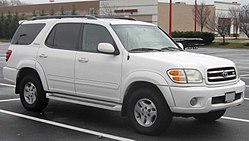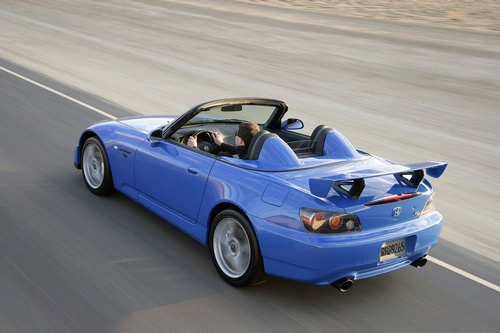Toyota Sequoia
 | |
| Manufacturer | Toyota Motor Corporation |
|---|---|
| Production | 2000�present |
| Model year(s) | 2001�present |
| Assembly | Princeton, Indiana, United States (TMMI) |
| Class | Full-size SUV |
| Body style(s) | 4-door SUV |
| Layout | Front engine, rear-wheel drive / four-wheel drive |
| Related | Toyota Tundra |
The Sequoia is the largest SUV currently sold under the Toyota name. Both the Sequoia and Land Cruiser seat eight passengers, however the Sequoia is being slightly larger than the Land Cruiser, giving it markedly larger leg room for the third row, and more cargo capacity behind its third row. Another difference is that the Sequoia is available in 2WD and its 4WD system is not the permanent 4WD system found in the Land Cruiser. Lastly the Land Cruiser is more luxurious and more upmarket, being the basis for the Lexus LX. As of 2010, the Sequoia is sold exclusively in the United States, Canada, Chile, Mexico, Puerto Rico and the Middle East.
First generation (2001�2007)
The Sequoia was originally shown in car shows in 1999 and 2000, with full production starting in late 2000 as a 2001 model. Engine, driveline, and some sheetmetal components are shared with the Tundra, and shares the same basic chassis, with the exception of rear disc brakes and a more sophisticated multi-link live axle rear suspension. The Sequoia was nominated for the North American Truck of the Year award for 2001. The Sequoia is slightly longer than the Land Cruiser, however, it is barely noticeable. At introduction it was larger than the Chevrolet Tahoe in most dimensions and similar in size to the Ford Expedition; its V8 engine was certified as Ultra Low Emission Vehicle. Frame assemblies and driveshafts are produced by Dana Corporation.The Sequoia comes in two trim levels; SR5 and Limited. The SR5 starts at $32,820 while the more expensive Limited starts at $41,855. It is sold in both two-wheel drive and four-wheel drive versions. Vehicle Stability Control was standard on models.
It received a mid-cycle update and minor cosmetic updates for 2005 and gained a more powerful engine equipped with VVT-i, as well as a 5-speed automatic transmission, replacing the previous 4-speed, LED-backlit gauges and an in-glass antenna replaces the previous power mast.
Toyota unveiled the 2008 Toyota Sequoia at the 2007 Los Angeles Auto Show, with sales beginning that following December. Like the previous Sequoia, the new model is based on the new Tundra. However major differences with the Tundra include a fully-boxed frame, a rear independent suspension featuring double wishbones with coil springs for improved ride comfort and room, and a locking center differential on 4-wheel drive models. The new suspension helps give the Sequoia a tighter turning radius of 19 feet (5.8 m) and allows for a fold-flat rear seat. Toyota stated the new frame is 70 percent more resistant to bending flex with torsional rigidity up 30 percent However, the new model weighs more than 500 lb (230 kg) more than the previous Sequoia. The drag coefficient has been reduced to 0.35.
Improvements include an optional ULEV-II compliant 381 horsepower 5.7-liter 3UR-FE V8, mated to a 6-speed automatic.
The 2008 Sequoia comes in three trim lines: the SR5 and Limited, and new Platinum. Pricing ranges from about $34,000 to $55,000 depending upon the trim line and configuration. The base engine is the previous ULEV complant 4.7-liter 2UZ-FE 276 horsepower (206 kW) V8 featured from the previous generation. The 4.7-liter is standard on the SR5, while the Limited and Platinum models come standard with a 5.7-liter V8 engine. Four-wheel drive is available on all models.
The interior of the 2008 Sequoia features the same dash as the new Tundra. Standard features include a tilt and telescopic steering wheel, power windows and doors, dual sun visors, and a keyless entry. Options include DVD based navigation with backup camera and 7" screen, a rear DVD entertainment system, a 14-speaker JBL audio system, and heated seats with ventilated coolers in the front row and warmers in the second row, available in Platinum trim. The Limited trim includes audio, climate, and hands-free Bluetooth mobile phone system controls, an improved JBL audio system, electroluminescent Optitron gauges, and an electrochromic auto-dimming rear-view mirror and side view mirrors with a HomeLink transceiver. The Platinum model includes a standard DVD navigation with a backup camera, a rear air suspension which can lower for easy loading, and Dynamic Laser Cruise Control.
Seating arrangements are for seven or eight passengers, eight for SR5 and Limited models and seven for Platinum models. Power folding 60/40 split third row seats are available on the Platinum. The Sequoia has a maximum towing capacity of 10,000 lbs (4,536 kg) with the 5.7-liter V8 in 2WD SR5 form or 9,600 lbs in the 4WD SR5 trim. Other versions tow considerably less, such as the 5.7-liter 4WD Platinum, which can tow 8,800 lbs (3,991 kg). The lowest towing capacity for the Sequioa is the 4.6-liter 4WD SR5, which tows 7,000 lbs (3,175 kg) For complete trailer & weight capacities, see Toyota�s website.
Exterior differences include door handle colors (color-keyed for the SR5; chrome for the Limited and Platinum), diamond-cut 20" aluminum alloy wheels for the Platinum trim, and varying power-heated remote-controlled side mirrors.
Standard safety features include Vehicle Stability Control, traction control, anti-lock brakes brake assist, electronic brakeforce distribution, front side torso airbags and roll-sensing side curtain airbags for all three rows. For the 2010 model knee airbags were added as standard feature for front driver and passenger safety.
Model year changes
- The 2009 model year adds E85 flex fuel capability for the 5.7-liter V8 sold in certain states.
- For the 2010 model year the 4.7-liter V8 is replaced by an all-new 4.6-liter 1UR-FE engine paired to a six-speed automatic transmission. The SR5 and Platinum trims become mono-spec and the Limited grade offers three stand alone options (navigation system, rear-seat entertainment and seven-passenger seating). Front driver and passenger knee airbags were added as a standard feature. Platinum models get wood trim on the steering wheel and shift gear, and Bluetooth and audio controls are standard on the SR5 trim. The Timberland Mica exterior color gets replaced with the new Camry's Spruce Mica. All audio systems have USB connectivity with iPod integration, and the rear-view mirror on the Limited trim has a built-in rearview camera.
Annual sales
| Calendar year | US sales |
|---|---|
| 2000 | 9,925 |
| 2001 | 68,574 |
| 2002 | 70,187 |
| 2003 | 67,067 |
| 2004 | 58,114 |
| 2005 | 45,904 |
| 2006 | 34,315 |
| 2007 | 23,273 |
| 2008 | 30,693 |
| 2009 | 16,387 |












